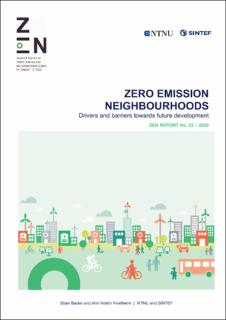Zero Emission Neighbourhoods. Drivers and barriers towards future development
| dc.contributor.editor | Backe, Stian | |
| dc.contributor.editor | Kvellheim, Ann Kristin | |
| dc.date.accessioned | 2020-06-11T10:44:02Z | |
| dc.date.available | 2020-06-11T10:44:02Z | |
| dc.date.issued | 2020 | |
| dc.identifier.isbn | 978-82-536-1662-9 | |
| dc.identifier.uri | https://hdl.handle.net/11250/2657684 | |
| dc.description.abstract | Spread and growth of zero emission neighbourhoods. This report describes the development of zero emission neighbourhoods and its drivers and barriers towards further development. The Norwegian context is used as a starting point, and the main focus is on technological, market related and societal aspects of zero emission neighbourhoods. The report is mainly built upon research in The Research Centre on Zero Emission Neigbourhoods in Smart Cities (FME ZEN) and its predecessor FME ZEB5, as well as a limited literature search and an FME ZEN internal workshop. Buildings account for a significant share of total energy use and climate gas emissions and are therefore important to address in order to reach national and international targets on decarbonisation. How buildings and neighbourhoods should be developed in order to contribute to this, is still researched. Technological development is important for choice of energy systems in a zero emission neighbourhood. Energy efficient appliances becomes increasingly common. Rapidly decreasing costs make renewable energy production economically viable, and in particular photovoltaics (PV) is made relevant for local production of electricity in neighbourhoods. A corresponding development is evident within battery technology and makes flexible use of energy possible through advanced smart metering (AMS) and systems of operation attached to stationary and mobile batteries. Flexible use of energy is a critical factor to achieve a high utilization of the renewable energy. How society interpret and relate to zero emission neighbourhoods is decisive for the future development Power supply in neighbourhoods is mainly solved through the power grid. Since the power grid is incredibly important in order to perform a central function for the society, the power market is regulated. Local energy systems in a zero emission neighbourhood can contribute to increased renewable energy production and alternative distribution of power through battery solutions. Such solutions can be more cost-effective than the traditional power grid, in particular in less urban areas. The integration of sustainable energy solutions on the local level requires a market that can capture the value of this contribution. Such markets can be complex in operation since several small contributions must be allocated within short timeframes. The connection between markets for materials and for energy systems is growing as a result of the development of building integrated energy production. How society interpret and relates to zero emission neighbourhoods is decisive for the future development. The innovative solutions in such areas are sometimes hindered by conservative regulations. Actors that administer relevant measures are important in order to enable cooperation about future development and spread of zero emission neighbourhoods. Based on identified drivers and barriers the report gives the following recommendations: Owners and developers: Set ambitious objectives and develop innovative and sustainable business models. Create a demand (and supply) for ZEN solutions through ambitious goals and long-term value creation. Engage users in co-creating attractive neighbourhoods. Support innovative approaches and acquire competence on smart technology. Supply and infrastructure: Challenge the current market with innovative business models and efficient solutions Grasp opportunities provided by technology development and digitalization. Create new business partnerships across disciplines and traditional markets (energy and building industry). Society and policy: Engage, and be engaged as citizens in the development of sustainable solutions. Frequently evaluate regulation limiting a ZEN based on updated research and development. Support research to develop more knowledge on the impact of a ZEN. Best practice projects is essential for learning and further development. These recommendations are elaborated through the report and particularly in chapter five. Authorities and academia/researchers have a particular responsibility when it comes to clarifying what role a zero emission neighbourhood can play in the transition to a low carbon society. We hope that this report can be a contribution in this respect. | |
| dc.language.iso | eng | |
| dc.publisher | SINTEF akademisk forlag | |
| dc.relation.ispartofseries | ZEN Report;22 | |
| dc.subject | Zero emission buildings | |
| dc.subject | Distributed energy resources | |
| dc.subject | Solar energy | |
| dc.subject | Energy storage | |
| dc.subject | Local energy markets | |
| dc.subject | Power market | |
| dc.subject | Market integration | |
| dc.subject | Building regulation | |
| dc.subject | Energy policy | |
| dc.subject | Stakeholder analysis | |
| dc.subject | Zero emission neighbourhoods | |
| dc.subject | Business models | |
| dc.title | Zero Emission Neighbourhoods. Drivers and barriers towards future development | |
| dc.type | Research report | |
| dc.description.version | publishedVersion | |
| dc.subject.nsi | VDP::Teknologi: 500 | |
| dc.identifier.cristin | 1815029 | |
| dc.relation.project | Norges forskningsråd: 257660 |
Tilhørende fil(er)
Denne innførselen finnes i følgende samling(er)
-
Rapporter fra SINTEF Community [790]
-
SINTEF Community [2248]
-
ZEN Reports [67]
